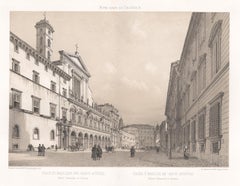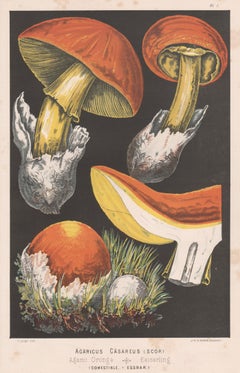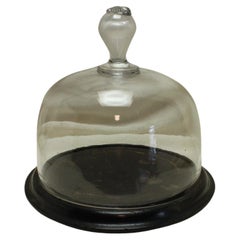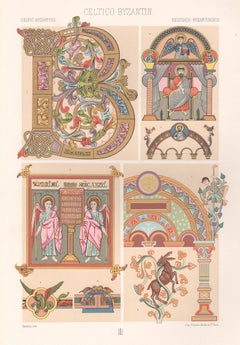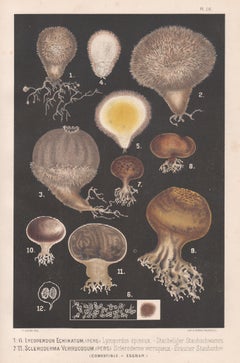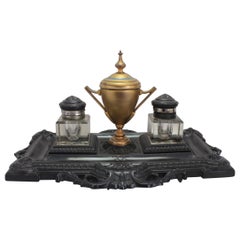Australia
to
10
30,266
26,068
3,754
2,771
2,555
1,146
902
798
534
520
515
470
380
357
245
219
208
184
182
167
143
123
96
85
83
65
50
50
37
35
31
26
22
22
21
20
20
19
17
13
13
11
11
7
7
6
6
2
2
2
1
1
1
1
22
17
12
10
8
Period: Late 19th Century
Piazza e Basilica de Santi Apostoli, Rome, Italy. Lithograph, Philippe Benoist
By Philippe Benoist
Located in Melbourne, Victoria
'Piazza e Basilica de Santi Apostoli. Palazzi Odescalchi e Colonna'
Tinted lithograph by Philippe Benoist (1813-1881). From a French series titled 'Rome dans Sa Grandeur', circa 18...
Category
Late 19th Century Victorian Australia
Materials
Lithograph
Agaricus Casareus, Leuba antique mushroom fungi botanical chromolithograph print
Located in Melbourne, Victoria
'Agaricus Casareus'
Antique Swiss mushroom / fungi chromolithograph, lithographed by H Furrer after Fritz Leuba. The print is titled with the scientific name...
Category
Late 19th Century Naturalistic Australia
Materials
Lithograph
French Glass Food Dome or Cloche on Stand
Located in East Geelong, VIC
This French glass food dome or cloche, sits on a wooden stand and was used to display or cover food. The hand blown dome measures 180 mm (7.25 inches) ...
Category
1890s French French Provincial Antique Australia
Materials
Blown Glass
Celtic-Byzantine, French antique 19th century Racinet art design print
Located in Melbourne, Victoria
'Celtic-Byzantine - Celtico-Byzantin - Keltisch-Byzantinisch'
Late 19th century interior design chromolithograph, from Racinet’s ‘L’Ornement Polychrome’, 1887. Published in Paris.
...
Category
Late 19th Century French School Australia
Materials
Lithograph
Lycoperdon Echinatum, Leuba antique mushroom fungi food chromolithograph print
Located in Melbourne, Victoria
'1-6 Lycoperdon Echinatum 7-11 Scleroderma Verrucosum' (Spiny puffball mushroom and Scaly earth ball)
Antique Swiss mushroom / fungi chromolithograph, lith...
Category
Late 19th Century Naturalistic Australia
Materials
Lithograph
Bois Durci Ink Stand
Located in East Geelong, VIC
This large Bois Durci ink stand features an intricately moulded base, upon which sit two glass inkwells and a central urn shaped container. The glass inkwel...
Category
1880s French High Victorian Antique Australia
Materials
Ebony
Minton Cherub Plate Pattern G1533
By Minton
Located in East Geelong, VIC
This Minton plate is decorated very simply with a central hand coloured transfer print of a cherub in puce (pattern G1533) The outer rim features a very fine basket weave moulding and the edge is finished with gilding. It was made in 1874 for the retailer John Mortlock...
Category
1870s English Victorian Antique Australia
Materials
Porcelain
Tartarin of Tarascon, by Alphonse Daudet, Rare C. 1887
Located in BALCATTA, WA
Get Tartarin of Tarascon, by Alphonse Daudet. Rare C. 1887. No Edition Remarks. 245 pages. No dust jacket. Half-bound brown leather with green cloth cover.
Category
1880s Antique Australia
Materials
Paper
Doulton Burslem Spanish Ware Painted Plate
By Doulton Burslem
Located in East Geelong, VIC
This porcelain plate from Doulton Burslem is decorated with s design from Doulton's "Spanish Ware" range. In this case a hand painted bough of raspberries, foliage and flowers has been done, using a very soft palette, and outlined in gold on a graduated fawn ground. This type of ware was developed by John...
Category
1890s English High Victorian Antique Australia
Materials
Porcelain
Sterling Silver Sifter Spoon London 1889
By Charles Harris
Located in East Geelong, VIC
This very decorative sterling silver sifter spoon was made by Charles Harris in London in 1889. On top of the barley twist handle is a cast silver...
Category
1880s English Late Victorian Antique Australia
Materials
Sterling Silver
Persian, French antique 19th century Racinet art design lithograph print
Located in Melbourne, Victoria
'Persian - Persan - Persisch'
Late 19th century interior design chromolithograph, from Racinet’s ‘L’Ornement Polychrome’, 1887. Published in Paris.
Albert Racinet's 'L' Ornement Po...
Category
Late 19th Century French School Australia
Materials
Lithograph
Alphonse Mucha -- The Flowers / Lily (Les Lys) 1898
By Alphonse Mucha
Located in BRUCE, ACT
Alphonse Mucha (Czech, 1860–1939)
Lily from The flowers
Les Lys : Les fleurs
Original Poster, 1898
Image size: 102.2×41.6 cm
Sheet size: 105.7×45.7 cm
Framed
Condition: laid down...
Category
1890s Australia
Materials
Lithograph
Astonishing 19th Century Rare Afshar Tribal rug featured in famous book
Located in WYNNUM, QLD
Featured as an exemplar of Afshar tribal creativity in James Opie's notable book " Tribal Rugs " this extremely rare collector's piece was used in a lecture series we conducted on the possible albeit unexamined influence of tribal rugs on early 20th century European painting .
The Afshars during the 19th century were amongst the dominant five nomadic groups in Iran and unquestionably the most daringly creative, and probably the most prolific in weaving output . Though the vast majority of their carpets exhibit traditional , more angular tribal patterns, this example is an extraordinary tribute to one female weaver as designer . There seems no precedent for the remarkable move into mind bending forms which veer off from the norm , which make it a high collectible and unquestionable investment piece .
The achievement of two elements stand out : colour and design execution . The rich and varied natural dye colours are deep and powerful and include a range from the treasured eggplant , through a provocative orange , yellows ( saffron), pale peach, to three unusual blues and a rare rust brown . Green is also sensitively applied to the palette .
The design also represents a departure from all norms before or since amongst Afshar rugs . The central medallions have been altered to create an almost moving, slightly hallucinatory effect ; the graceful tumbling of coloured leaves or vines is singular in its presentation, graceful yet very much alive . Most interesting are the designs within the medallion which seem to be an evocation of the ancient Chinese dragon and phoenix symbols . This theory gains a bit more traction when you look at the upright shrine type figure rising up alongside the medallions - these appear Chinese , as well, in a semi- abstract way-- influences such as these had been travelling across thewide continent of Asia for millenia .
The borders are classic traditional Afshar , noted for their lovely re-creation of flower symbols , interlinking , and slightly irregular , showing the artistic seredipity of the artist/ weaver . The colours here too, particularly the blues and yellows are nothing short of spectacular .
The amount of detailled hand work suggests that this piece would have required at least two years work on a ground loom- a humbling thought in thinking about the nomadic life in the 19th century.
This rug is of a size and of such a beauty that in the right open modern decor, it could well occupy a wall space of distinction, as would a modern art canvas...
Category
1880s Persian Antique Australia
Materials
Wool
Doulton Burslem Spanish Ware Painted Plate
By Doulton Burslem
Located in East Geelong, VIC
This porcelain plate from Doulton Burslem is decorated with Doulton's "Spanish Ware" pattern with hand coloured flowers outlined in gold on a pink ground with a painted background. This type of ware was developed by John Slater...
Category
1880s English High Victorian Antique Australia
Materials
Porcelain
La Via Sacra, Rome, Italy. Tinted lithograph, Felix Benoist
By Felix Benoist
Located in Melbourne, Victoria
'La Via Sacra, Arco di Constantino e Tempio di Venere e Roma, colla Meta Sudante, Veduta presa del Colosseo'
Tinted lithograph by Eugene Cicero af...
Category
Late 19th Century Victorian Australia
Materials
Lithograph
Old Norfolk Breed, sheep lithograph with original hand-colouring, circa 1845
By After William Shiels
Located in Melbourne, Victoria
'Ancienne Race de Norfolk (The Old Norfolk Breed) '
Lithograph with original hand-colouring by Hermann Eichens (1813-1886) from a drawing by W. Nicholson after a painting by Willia...
Category
Late 19th Century Naturalistic Australia
Materials
Lithograph
Morchella Lutescens, Leuba antique mushroom morel fungi chromolithograph print
Located in Melbourne, Victoria
'1-4 Morchella Lutescens 5-7 Morchella Abietina'
Antique Swiss mushroom / fungi chromolithograph, lithographed by H Furrer after Fritz Leuba. The print is titled with the scientific...
Category
Late 19th Century Naturalistic Australia
Materials
Lithograph
Minton Blue and White Tureen "Bath Japan" Pattern
By Minton
Located in East Geelong, VIC
This large blue and white soup tureen was made by Minton and is decorated with the printed pattern "Bath Japan". The pattern consists of scattered flowers with borders resembling woven Japanese mats...
Category
1870s English Japonisme Antique Australia
Materials
Earthenware
John Gould - Naga Nuthatch from 'The Birds of Asia' c.1850
By John Gould
Located in BRUCE, ACT
Naga Nuthatch - John Gould lithograph with hand-coloured
size 54 cm X 37 cm
excellent Condition
Accompanied by the information page from 'The Birds of Asia...
Category
Late 19th Century Australia
Materials
Lithograph
Indian, French antique 19th century Racinet art design lithograph print
Located in Melbourne, Victoria
'Indian - Indou - Indisch
Late 19th century interior design chromolithograph, from Racinet’s ‘L’Ornement Polychrome’, 1887. Published in Paris.
Albert Racinet's 'L' Ornement Polych...
Category
Late 19th Century French School Australia
Materials
Lithograph
Antique 19th century Afshar , Perfect condition , Plush
Located in WYNNUM, QLD
From a Boston Collector.
Remarkably Creative.
This is another of our small stock of Afshar collectibles which astonish as to their artistic form. This example was recently acquired from a Boston collector’s estate. The wool, very soft, is of excellent quality and the weave very fine, the rug in superior condition.
Boston Antique carpet expert Michael Grogan declared it as one of the very finest and most original Afshar rugs he had ever seen.
This piece was recently used along with two others in a lecture series which pondered the question of likely influence of tribal (and arguably other Persian e,g, Montasham Kashan) rugs on the development of Western 20th century painting.
The abrupt break with traditional forms by a gifted female weaver in a remote location and in the throes of a nomadic life, considering her circumstances, is awe inspiring.
The wide and in cases unusual colors deployed (note the dark browns probably achieved with walnut shells in the dye vat...
Category
1890s Persian Antique Australia
Materials
Wool
Middle Ages, French antique 19th century Racinet art design lithograph print
Located in Melbourne, Victoria
'Middle Ages - Moyen-Age - Mittel Alter'
Late 19th century interior design chromolithograph, from Racinet’s ‘L’Ornement Polychrome’, 1887. Published in Paris.
Albert Racinet's 'L' ...
Category
Late 19th Century French School Australia
Materials
Lithograph
Antique Sultanabad Investment Piece
Located in WYNNUM, QLD
From a prominent East Coast USA Dealer
Sultanabad is the former name of Arak, a main center for weaving, and the locale of the famous Ferahan Sarouks, amongst other classic types and styles .
In the late 19th century several significant European based companies established there to produce quality rugs and especially larger carpets for the Western market, utilyzing local talent. (Foremost among these was the Zeigler firm, and Zeigler Sultanabads...
Category
Late 19th Century Persian Antique Australia
Materials
Wool
French Silver Cake Slice with Gilt Blade
Located in East Geelong, VIC
This very attractive French silver cake slice, or dessert spoon, features an embossed silver handle and a silver gilt blade which is very slightly di...
Category
1890s French Belle Époque Antique Australia
Materials
Silver
Agaricus Arvensis, Leuba antique mushroom fungi chromolithograph print
Located in Melbourne, Victoria
'Agaricus Arvensis'
Antique Swiss mushroom / fungi chromolithograph, lithographed by H Furrer after Fritz Leuba. The print is titled with the scientific name...
Category
Late 19th Century Naturalistic Australia
Materials
Lithograph
Striking Afshar Bidjar Antique, Collectible Investment Piece at Special Discount
Located in WYNNUM, QLD
Rare Afshar Bidjar 1880
BIDJAR (AFSHAR BIDJAR RARE VARIANT) 1880 or earlier
6 x 4 feet
Acquired from an Australian collector
Bidjar carpets are known as the iron carpet...
Category
1880s Antique Australia
Materials
Wool
Aristocratic Ferahan Sarouk 1890 Antique Short Term Reduction
Located in WYNNUM, QLD
ARISTOCRATIC Ferahan Sarouk 1890
Measures: 6 ft 8 inches x 4 foot 4 inches
Ladies, if you seek a gift for your much loved man, to make him feel like...
Category
1890s Persian Antique Australia
Materials
Wool
Greek-Byzantine, French antique 19th century Racinet art design lithograph print
Located in Melbourne, Victoria
'Greek-Byzantine - Greco-Byzantin - Griechisch-Byzantinisch'
Late 19th century interior design chromolithograph, from Racinet’s ‘L’Ornement Polychrome’, 1887. Published in Paris.
A...
Category
Late 19th Century French School Australia
Materials
Lithograph
Middle Ages, French antique 19th century Racinet art design lithograph print
Located in Melbourne, Victoria
'Middle Ages - Moyen-Age - Mittel Alter'
Late 19th century interior design chromolithograph, from Racinet’s ‘L’Ornement Polychrome’, 1887. Published in Paris.
Albert Racinet's 'L' ...
Category
Late 19th Century French School Australia
Materials
Lithograph
Italian 20th Century Modernist Magis Condor Andries and Hiroko Van Onck Stools
By Magis, Andries & Hiroko van Onck
Located in Byron Bay, NSW
Italian 20th century modernist Magis Condor Andries and Hiroko Van Onck bar stools bar set of four
Metal frame and plastic seats.
Category
1880s Italian Post-Modern Antique Australia
Materials
Metal
Miniature Copper Kettle, Salesman's Sample
Located in East Geelong, VIC
This miniature copper kettle was probably a salesman's sample, which would be far easier to carry around than a proper sized one. The body is copper, the knob for the lid is brass, a...
Category
1880s English Victorian Antique Australia
Materials
Copper
Morchella Esculenta, Leuba antique mushroom morel fungi chromolithograph print
Located in Melbourne, Victoria
'1-2 Morchella Esculenta 3.5. Morchella Viridis'
Antique Swiss mushroom / fungi chromolithograph, lithographed by H Furrer after Fritz Leuba. The print is titled with the scientific...
Category
Late 19th Century Naturalistic Australia
Materials
Lithograph
Arabian, French antique 19th century Racinet art design lithograph print
Located in Melbourne, Victoria
'Arabian - Arabe - Arabisch'
Late 19th century interior design chromolithograph, from Racinet’s ‘L’Ornement Polychrome’, 1887. Published in Paris.
Albert Racinet's 'L' Ornement Pol...
Category
Late 19th Century French School Australia
Materials
Lithograph
Agaricus Mappa, Leuba antique mushroom fungi chromolithograph print
Located in Melbourne, Victoria
'Agaricus Mappa' (False death cap )
Antique Swiss mushroom / fungi chromolithograph, lithographed by H Furrer after Fritz Leuba. The print is titled with the scientific name below t...
Category
Late 19th Century Naturalistic Australia
Materials
Lithograph
Impeccable Artistic Antique Ferahan Sarouk, 1880
Located in WYNNUM, QLD
Acquired from a Swedish collector
Ferahan Sarouk carpets produced around the wider Arak (city) area from about 1850-1900 earned a deserved reputation as amongst the most desirable and imaginative finely woven carpets in Persia. As these things go, they morphed in style around 1910- 1920 into the differently woven Mahajirhan Sarouk fashion (quality examples of which are also in demand) and then disappeared entirely.
Their desirability rests not only on fine weaving, and excellent wool. Many of the better examples were commissioned by aristocrats or wealthy merchants who encouraged new approaches and creativity, one source of their excellence.
Beyond this lay a more fundamental and seemingly contradictory set of motivations by the weavers. At one and the same time they sought to emulate the great court carpets in finesse and design, and yet-- they applied rustic or village, and even tribal elements and nuances to their designs. The result was a cavalcade of creativity.
So, a village-based genre came into being which produced primarily an approx. 6x4 rug size format, and also provided, if more rarely, larger formats, which command increasingly high prices, due to their rarity, visual excitement and grandeur.
The artistic achievement of this “school” had to do with marrying elegance and a degree of formalism with whimsy, and design innovation. They offer a charm and a certain magic beyond that of court and most city carpets.
As in any area or era, there is a quality spectrum ranging from mediocre to highly superior. Superiority is judged of course as to weave and wool quality. It is rather unusual, though, to encounter pieces made before 1890 -which are bona fide Ferahan Sarouks- with poor wool or weaving: standards were upheld during this period, and natural dyes employed universally.
Thus, as an investment collectible to adorn the home we believe the ultimate criterion is aesthetics, this being an art form, after all.
Ferahan Sarouks have been a special area of interest for us over the decades both from artistic and investment perspectives.
Allowing for personal taste, our suggestions are few and simple. A Ferahan Sarouk ought to display a wide colour palette, fine and creative drawing and delicate, sometimes “intense “detail. The finest pieces also display balance in the use of space.
We have seen many finely woven pieces which in our view are garish and lack one of the two key artistic elements intrinsic to the better examples of this genre – elegance. Sometimes they are overly cluttered; the drawing artistry is muddled or lost. In other cases odd and ineffective design devices are used, detracting from or interfering with an otherwise good design. The era of the Ferahan Sarouk was rife with experiment, not all of them successful.
The other important attribute, when it can be found, is original artistic creativity, even serendipity, -- or effective design innovation within the compass of this rug type and the unique standards of its prime period.
On average, we examine between 20-30 antique Ferahan Sarouks...
Category
Late 19th Century Persian Antique Australia
Materials
Wool
Antique 1880 Shirvan Caucasian investment carpet . rare, excellent condition
Located in WYNNUM, QLD
From a Philadelphia Collector
This is a very robust member of the esteemed, and increasingly rare 19th century Afstaka “family”. It is slightly longer and wider than many exam...
Category
1870s Azerbaijani Antique Australia
Materials
Wool
Doulton Lambeth Stoneware Egyptian Revival Jug
By Doulton Lambeth
Located in East Geelong, VIC
A very attractive salt glazed stoneware jug from the Doulton Lambeth factory. It is decorated with a rather uncommon Egyptian theme. A pharaoh's head forms the spout and the wings of...
Category
1890s English Egyptian Revival Antique Australia
Materials
Earthenware
Fistulina Hepatica, Leuba antique mushroom fungi chromolithograph print
Located in Melbourne, Victoria
'1-3 Fistulina Hepatica 4-6 Boletus Chrysentheron'
Antique Swiss mushroom / fungi chromolithograph, lithographed by H Furrer after Fritz Leuba. The print is titled with the scientif...
Category
Late 19th Century Naturalistic Australia
Materials
Lithograph
Agaricus Vaginatus, Leuba antique mushroom fungi chromolithograph print
Located in Melbourne, Victoria
'Agaricus Vaginatus' (grisette or the grisette amanita)
Antique Swiss mushroom / fungi chromolithograph, lithographed by H Furrer after Fritz Leuba. The print is titled with the sci...
Category
Late 19th Century Naturalistic Australia
Materials
Lithograph
Boletus Edulis, Leuba antique mushroom fungi chromolithograph print
Located in Melbourne, Victoria
'Boletus Edulis
Antique Swiss mushroom / fungi chromolithograph, lithographed by H Furrer after Fritz Leuba. The print is titled with the scientific name bel...
Category
Late 19th Century Naturalistic Australia
Materials
Lithograph
High Collectible 19th Century Ferahan Sarouk, Princely, at Short Term Reduction
Located in WYNNUM, QLD
Ferahan Sarouk Museum Quality
MUSEUM QUALITY Ferahan Sarouk, third quarter 19th century
6.6 x 4.5 feet
From a USA collector
Ferahan Sarouk carpets produced around the wider Arak (formerly Sultanabad) area from about 1850-1910 earned a deserved reputation as amongst the most desirable and imaginative finely woven carpets in Persia. As these things go, they morphed in style around 1910- 1920 into the differently woven Mahajirhan Sarouk fashion (quality examples of which are also in demand) and then disappeared entirely.
Their desirability rests not only on fine weaving, and excellent wool. Many of the better examples were commissioned by aristocrats or wealthy merchants who encouraged creativity, in an actively competitive way; rugs during this period, as before, were direct illustrations of an individual’s wealth, power and prestige.
Beyond this lay a more fundamental and seemingly contradictory set of motivations by the weavers. At one and the same time they sought to emulate the great court carpets in finesse and design. And yet-- they applied rustic or village, and even tribal elements and nuances to their designs. The result was a cavalcade of creativity.
So, a village-based genre came into being which produced primarily an approx. 6x4 rug size format, and also provided, if more rarely, larger formats, which command increasingly high prices, due to their rarity, visual excitement and grandeur.
The artistic achievement of this “school” had to do with marrying elegance and a degree of formalism with whimsy, and design innovation. They offer a charm and a certain magic beyond that of court and most city carpets.
As in any area or era, there is a quality spectrum ranging from mediocre to highly superior. Superiority is judged of course as to weave and wool quality. It is rather unusual, though, to encounter pieces made before 1890 -which are bona fide Ferahan Sarouks- with poor wool or weaving: standards were upheld during this period, and natural dyes were widely employed, particularly in the wider Arak (then Sultanabad) region.
Thus, as an investment collectible to adorn the home we believe the ultimate criterion is aesthetics, this being an art form, after all.
Ferahan Sarouks have been a special area of interest for us over the decades both from artistic and investment perspectives.
Allowing for personal taste, our suggestions are few and simple. A Ferahan Sarouk ought to display a wide colour palette, fine drawing and delicate, sometimes “intense “ detail. The finest pieces also display an elevated sense of balance in the use of space.
We have seen many finely woven pieces which in our view are garish and lack one of the two key artistic elements intrinsic to the better examples of this genre – elegance. Sometimes they are overly cluttered; the drawing artistry is muddled or lost. In other cases odd and ineffective design devices are used, detracting from or interfering with an otherwise good design. The era of the Ferahan Sarouk was rife with experiments, not all of them successful.
The other important attribute, when it can be found, is original artistic creativity, even serendipity, -- or effective design innovation within the compass of this rug type and the unique standards of its prime period.
On average, we examine between 30-40 antique Ferahan Sarouks to achieve one acquisition, for the benefit of our clients.
This highly collectible more than 150-year-old carpet is an apex achievement of superior artistry and innovation. As an exemplar of its genre, it can be reasonably described as Museum quality, a term we do not often employ.
Please observe the stunning precision of the inner guard and its pinpoint sharp hooks. The elongation of the central medallion is one of its subtle but powerful innovations in form. The nod to asymmetry – which displays a refined sense of humour - is seen in the use of the small diamond figures, as one is deliberately missing from the right hand side: a wry nod to asymmetry, in an otherwise perfectly symmetrical creation.
The ultimate achievement here is in the fineness of the weaving itself, on close inspection. The herati pattern in the medallion and corners achieves an etched-on quality, a very uncommon level of attention to detail and perfectionism: clearly the work of a master. This artistic sense extends to the outer ground which is a superb example of the most subtle abrash, one of the most refined we have had the honor of viewing. The unusual beige/brown tones in the field were probably achieved by adding onion skins to the die vat. These extremely fine gradations of colour are rarely seen.(NB the colour photographs create a slightly misleading- overly yellow burnish to the field colour in spite of expert photographic efforts ) .
The deliberate choice of an ink black use of indigo provides a powerful frame (border) for this piece of art, which note in the lower right-hand corner is lifted slightly through abrash to a deep blue – to highlight the design and use of emerald green in the rosettes. The green shades lighten as the border ascends harmonizing with the tones in the central medallion.
The floating flow of flowers in the border is beautifully executed, with up to seven colours in a single figure.
No doubt a piece commissioned by an aristocrat around 1870, it is – remarkably- in virtually perfect condition. It appears to have had very minimal footwear, and great care; a piece which was proudly displayed from time to time and appreciated. Its density and strong foundation would however allow regular use within a home, and in a spacious contemporary home or office could make a wall hanging of striking impact.
This remarkable one of a kind piece is on short term reduction to coincide with our launch on 1st Dibs . Fair market value is approximately $22,000 .
Fine art as investment ? The WSJ made the following comments this year :
The vigor of the art market may seem counterintuitive, but it makes sense in the current environment,” economist Tyler Cowen recently wrote in The Washington Post. “First, many of the wealthy have been buying additional homes and wish to furnish them with art. Second, the recent run-up in inflation rates around the world has intensified the search for hedges.”
While the aforementioned artworks fall into traditional categories, some less-prominent forms of fine art also represent ideal investment opportunities, especially because they offer more attractive—i.e., significantly less costly—entry points for new collectors. Take high-collectible and connoisseur-caliber antique Oriental rugs, for example. The best 19th-century examples often sell privately between five figures and low six figures.
Today, that obscurity is fading. According to Ben Evans, the editor of Hali Magazine—a publication dedicated to the international rug and textile market—there are two primary factors to explain why antique rugs are beginning to enjoy their moment in the spotlight. “Cultural curiosity and collecting...
Category
1880s Persian Antique Australia
Materials
Wool
Hydnum Coralloides, Leuba antique mushroom fungi chromolithograph print
Located in Melbourne, Victoria
'1 Hydnum Coralloides 2 Hydnum Erinaceus' (Coral Tooth Fungus and Lion mane's mushroom)
Antique Swiss mushroom / fungi chromolithograph, lithographed by H Furrer after Fritz Leuba. ...
Category
Late 19th Century Naturalistic Australia
Materials
Lithograph
French Fabric Design - Etoffe Francais, antique French chromolithograph print
Located in Melbourne, Victoria
'Les Arts Décoratifs - Etoffe de Genes'
Depicts fabric from the 17th century. From 'Les Arts Decoratifs a toutes les epoques', printed by Lemercier & Cie, Paris.
300mm by 200mm (i...
Category
Late 19th Century Victorian Australia
Materials
Lithograph
Circa 1880, Venezia, Italy Hand-Painted Pine Armoire
Located in BALCATTA, WA
This incredible pine armoire was found in Venezia, Italy, and has been dated at approximately C. 1880. Delicate, Hand painted foliage on the armoire doors trail down to a depiction o...
Category
1880s Antique Australia
Materials
Pine
Portland Vase, Northwood, Wedgwood, circa 1880
By Wedgwood
Located in Melbourne, Victoria
One of the finest copies of The Portland Vase that Wedgwood produced, in many ways rivalling the First Edition itself.
Decorated by Thomas Lovatt, then cut, polished and shaded by John Northwood in his glass engraving studio. Although 30 copies were intended, the work was so exacting and arduous that in the end only thirteen were finished.
The mirrored stand, which is included, is later and I think dates from the late 20th century. Of all the stands designed for the Portland Vase, this is the best I've seen.
The original Portland vase, dating from around 200AD and made of cameo glass, is considered one of the most important examples of classical design and is noted for its intricate relief sculptures, which depict classical figures and scenes from Greek mythology - exactly what, though, we're not sure.
The original Wedgwood Portland Vase...
Category
1880s English Neoclassical Antique Australia
Materials
Pottery
Late 3rd Quarter 19th Century Antique Ferahan Sarouk, Glorious Flowers
Located in WYNNUM, QLD
Ferahan Sarouk, 1870 :GLORIOUS FLOWERS
.
From a German collector
Ferahan Sarouk carpets produced around the wider Arak (formerly Sultanabad) are...
Category
1870s Persian Antique Australia
Materials
Wool
Celtic, French antique 19th century Racinet art design lithograph print
Located in Melbourne, Victoria
'Celtic - Celtique - Keltisch'
Late 19th century interior design chromolithograph, from Racinet’s ‘L’Ornement Polychrome’, 1887. Published in Paris.
Albert Racinet's 'L' Ornement P...
Category
Late 19th Century French School Australia
Materials
Lithograph
Persian, French antique 19th century Racinet art design lithograph print
Located in Melbourne, Victoria
'Persian - Persan - Persisch'
Late 19th century interior design chromolithograph, from Racinet’s ‘L’Ornement Polychrome’, 1887. Published in Paris.
Albert Racinet's 'L' Ornement Po...
Category
Late 19th Century French School Australia
Materials
Lithograph
Basilica di St Maria Maggiore, Rome, Italy. Tinted lithograph, Philippe Benoist
By Philippe Benoist
Located in Melbourne, Victoria
'Basilica di St Maria Maggiore. Veduta della facciata principale'
Tinted lithograph by Philippe Benoist (1813-1881). From a French series titled 'Rome dans Sa Grandeur', circa 1870...
Category
Late 19th Century Victorian Australia
Materials
Lithograph
Kiwi, Apteryx Owenii, New Zealand bird lithograph with hand-colouring, c1875
Located in Melbourne, Victoria
'Apteryx Owenii Juv.' (Young Grey Kiwi)
From G.D. Rowley's, 'Ornithological Miscellany', 1875 - 78.
Johannes Gerardus Keulemans (1842 - 1912) was a Dutch bird...
Category
Late 19th Century Victorian Australia
Materials
Lithograph
Helvella Crispa, Leuba antique mushroom fungi chromolithograph print
Located in Melbourne, Victoria
'1-2 Helvella Crispa 3-6 Peziza Repanda' (White Saddle and Palomino cup)
Antique Swiss mushroom / fungi chromolithograph, lithographed by H Furrer after ...
Category
Late 19th Century Naturalistic Australia
Materials
Lithograph
Two Royal Worcester Blush Ivory dishes in the shape of a cabbage leaf
By Royal Worcester
Located in East Geelong, VIC
These very pretty porcelain dishes were part of Royal Worcester's Blush Ivory range. The decoration on the creamy Blush Ivory ground consists of a variety of hand painted flowers and...
Category
1890s English Late Victorian Antique Australia
Materials
Porcelain
Middle Ages, French antique 19th century Racinet art design lithograph print
Located in Melbourne, Victoria
'Middle Ages - Moyen-Age - Mittel Alter'
Late 19th century interior design chromolithograph, from Racinet’s ‘L’Ornement Polychrome’, 1887. Published in Paris.
Albert Racinet's 'L' ...
Category
Late 19th Century French School Australia
Materials
Lithograph
Middle Ages, French antique 19th century Racinet art design lithograph print
Located in Melbourne, Victoria
'Middle Ages - Moyen-Age - Mittel Alter'
Late 19th century interior design chromolithograph, from Racinet’s ‘L’Ornement Polychrome’, 1887. Published in Paris.
Albert Racinet's 'L' ...
Category
Late 19th Century French School Australia
Materials
Lithograph
Royal Worcester Blush Ivory Flower Holder
By Royal Worcester
Located in East Geelong, VIC
This unusual Royal Worcester vase is shown in the Worcester list of shapes as a "Flower holder claw feet". It could also be described as a specimen vase....
Category
1890s English Late Victorian Antique Australia
Materials
Porcelain
Russian, French antique 19th century Racinet art design lithograph print
Located in Melbourne, Victoria
'Russian - Russe - Russisch'
Late 19th century interior design chromolithograph, from Racinet’s ‘L’Ornement Polychrome’, 1887. Published in Paris.
Albert Racinet's 'L' Ornement Pol...
Category
Late 19th Century French School Australia
Materials
Lithograph
John Gould - Himalayan Nuthatch from 'The Birds of Asia' c.1850
By John Gould
Located in BRUCE, ACT
Himalayan Nuthatch - John Gould lithograph with hand-coloured
size 54 cm X 37 cm
excellent Condition
Accompanied by the information page from 'The Birds of Asia...
Category
Late 19th Century Australia
Materials
Lithograph
Russian, French antique 19th century Racinet art design lithograph print
Located in Melbourne, Victoria
'Russian - Russe - Russisch'
Late 19th century interior design chromolithograph, from Racinet’s ‘L’Ornement Polychrome’, 1887. Published in Paris.
Albert Racinet's 'L' Ornement Pol...
Category
Late 19th Century French School Australia
Materials
Lithograph
London, England, birds-eye view, chromolithograph, c1870
Located in Melbourne, Victoria
London, England, birds-eye view, chromolithograph, c1870 published by William Collins.
175mm by 225mm (image) 270mm by 335mm (sheet)
Category
Late 19th Century Naturalistic Australia
Materials
Lithograph
Middle Ages, French antique 19th century Racinet art design lithograph print
Located in Melbourne, Victoria
'Middle Ages - Moyen-Age - Mittel Alter'
Late 19th century interior design chromolithograph, from Racinet’s ‘L’Ornement Polychrome’, 1887. Published in Paris.
Albert Racinet's 'L' ...
Category
Late 19th Century French School Australia
Materials
Lithograph
